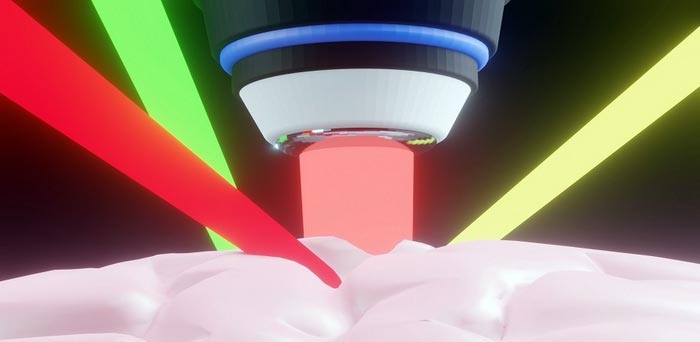High-performance 937-nm laser: see deeper with lower power

Low-repetition-rate laser excites multiple fluorescence signals.
Courtesy of T. Qiao (HKU)
High-performance laser offers a new kind of light source for multiphoton microscopy, requiring only 10 mW of power to image tissue at depths of over 600 µm.
Two-photon microscopy (2PM) plays a reliably efficient role in noninvasive deep-tissue imaging in biomedical investigation. Since the invention of the two-photon microscope at the end of the 20th century, there has been a steady flow of related research advancing 2PM—from fluorophores to imaging methods and applications—in the fields of biochemistry and medicine.
How to image deeper tissues has been a great challenge in two-photon imaging. Laser sources can potentially address that challenge. However, the traditional Ti:sapphire mode-locked laser for two-photon imaging is limited by its high repetition frequency and cannot provide the high pulse energy needed for deep tissue imaging at low exposure power. The fiber laser overcomes the high repetition rate conveniently by adding a few dozen meters of fibers in the cavity, but in some cases it suffers from low gains and low signal-to-noise ratio (SNR).
Recently, as reported in Advanced Photonics Nexus, researchers from Kenneth Wong’s Omega Group at University of Hong Kong (HKU) developed a high-performance laser as a new kind of light source for multiphoton microscopy. They reported a 937-nm laser, frequency doubled from an all-fiber mode-locked laser at 1.8 μm, with a low repetition rate of ~9 MHz and a high SNR of 74 dB.
The novel 937-nm laser source relies on self-phase modulation in the single-mode fiber to simultaneously boost the 1.8 μm power and compress the pulse width. The 937-nm laser design is suitable for high-sensitivity deep-tissue imaging of multiple fluorescence proteins. The laser light source provides two-photon excitations on multiple biological tissue types. The penetration depth demonstrated with a mouse brain reached 620 μm, revealing the capability of this technique for deep tissue imaging. The researchers also conducted second-harmonic generation (SHG) imaging, demonstrating label-free imaging and initially validating the potential of this light source for multimodal imaging applications.
Thanks to its low repetition frequency and high signal-to-noise ratio, the light source requires only 10 mW of power to image tissue at depths of over 600 µm, significantly lower than the 40-MHz fiber laser, which requires approximately 200-mW power at a similar depth. This greatly reduces photobleaching and photodamage in imaging, improving the depth of tissue imaging and safety in live (in vivo) imaging.
This work will facilitate greater insights into deep tissue imaging for research and biomedical applications. Postdoctoral fellow at HKU and corresponding author Tian Qiao remarks, “This novel high-SNR 937-nm laser source achieves a good balance between sensitivity, penetration depth, and imaging speed for two-photon imaging. Its great performance in two-photon imaging indicates its exciting potential for biological investigations, such as in vivo deep-tissue imaging and multimode imaging.”
Read the Gold Open Access article by H. He, H. Tang, et al., “Deep-tissue two-photon microscopy with a frequency-doubled all-fiber mode-locked laser at 937 nm,” Adv. Photon. Nexus, 1(2), 026001 (2022), doi 10.1117/1.APN.1.2.026001.
Journal: Advanced Photonics Nexus
DOI: 10.1117/1.APN.1.2.026001
Article Title: Deep-tissue two-photon microscopy with a frequency-doubled all-fiber mode-locked laser at 937 nm
Article Publication Date: 11-Aug-2022
Media Contact
Daneet Steffens
SPIE–International Society for Optics and Photonics
daneets@spie.org
Office: 360-685-5478
All latest news from the category: Medical Engineering
The development of medical equipment, products and technical procedures is characterized by high research and development costs in a variety of fields related to the study of human medicine.
innovations-report provides informative and stimulating reports and articles on topics ranging from imaging processes, cell and tissue techniques, optical techniques, implants, orthopedic aids, clinical and medical office equipment, dialysis systems and x-ray/radiation monitoring devices to endoscopy, ultrasound, surgical techniques, and dental materials.
Newest articles

Hyperspectral imaging lidar system achieves remote plastic identification
New technology could remotely identify various types of plastics, offering a valuable tool for future monitoring and analysis of oceanic plastic pollution. Researchers have developed a new hyperspectral Raman imaging…

SwRI awarded $26 million to develop NOAA magnetometers
SW-MAG data will help NOAA predict, mitigate the effects of space weather. NASA and the National Oceanic and Atmospheric Administration (NOAA) recently awarded Southwest Research Institute a $26 million contract…

Protein that helps cancer cells dodge CAR T cell therapy
Discovery could lead to new treatments for blood cancer patients currently facing limited options. Scientists at City of Hope®, one of the largest and most advanced cancer research and treatment…



